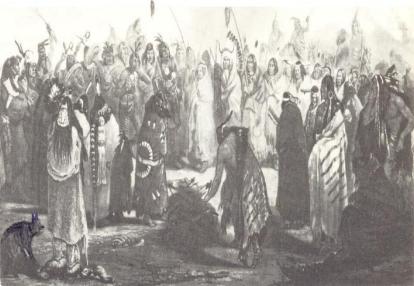|
Song
Dog Kennels
|
|
|
|
Home
of SONG DOG KENNELS -- Sole copyrighted Registry for the AMERICAN
INDIAN DOGS
|
Indian Dogs Rare, But not ExtinctLifestyles - The Dispatch - Friday, January 5, 1990Kathy McKenzie Nichols - The Write Stuff
I'll bet you never thought that the family pet could be a piece of living history. But that's exactly what the American Indian dog seems to be. Now I know all of you out there are saying to yourselves, "Huh?" This is to be expected. The Indian dog is a rare breed - literally. If you haven't heard of it before, you're not alone. I happened to meet the fellow who is president of the American Indian Dog Club, who lives in Prunedale. Prunedale happens to be just south of Aromas, which is just south of Gilroy. He had left his card on the bulletin board at the Aromas Feed Store and I spotted it. So like any inquisitive journalist, I felt honor bound to call and inquire: Just what exactly was an American Indian Dog? Club President Kim La Flamme is a soft spoken gent - so much so that sometimes it's hard to catch what he's saying. A carpenter by trade, he is part Blackfoot Indian, part French. He grew up with Indian dogs, and decided about 20 years ago that someone had to do something to save the breed. One problem: Experts thought the dogs were extinct. Kim had to prove they weren't. He's spent much of his life documenting his dogs' heritage. "Educating people is the hard part," he said with a sigh. Now, some 120 dogs have been identified as purebred Indian Dogs throughout the country. Kim has a breeding program going. The breed will also be included in the next edition of the Rare Breed Handbook, a standard in the world of dog texts. Indian dogs look like well fed, thick-furred coyotes, but are much friendlier. They come in four basic colors: pale or white (often with blue eyes), brown, black and red. Kim has about 10 dogs in his backyard, males separated from females. Right now, the breeding season is under way, and the animals pace nervously in their kennels. I asked Kim how he identified the dogs. "We looked for documentation - proof that they came from a reservation or that they belonged to an Indian family," he said. Despite their looks, the dogs have the personality of domesticated animals. Intelligent, quick and agile, they are shy around strangers, but protective of their human families. In fact, according to Kim, the dogs were often used as baby sitters in the native American villages - children that strayed too far were 'herded' back to the teepee. Kim mentions a particular "problem" one club member is having with an Indian dog. The dog gets upset whenever the member's children are playing in the family's swimming pool, thinks they're drowning, and jumps over the pool fence to rescue them!! The dog pulls them all out, much to their consternation. American Indian dogs were domesticated some 30,000 years ago, and most likely did have coyotes or wolves as ancestors, according to zoologists and anthropologists who Kim has worked with. The dogs could be found in every corner of North America and served many different functions. Some tribes used them for herding or hunting. Others had them pull loads on a travois. The Klamath Indians, Kim says, used the dog's hair in their weaving. Dogs were also employed in religious ceremonies, particularly the white, blue-eyed one, called "spirit dogs". Twenty years is a long time to invest in any project. Kim is finally making headway in his efforts to preserve the breed. He also takes the dogs to Indian events, kennel club expositions and schools, in order to tell people about them.Kim thinks the public education is important for the historical window it provides on Native American's lives. His biggest worry is that the dogs might be mistaken for wild animals and be shot, which is why he's trying to spread the word about the breed.At the same time, Kim is not interested in getting his dogs into the American Kennel Club. "I don't want to get into showing too much," he said. "We're looking at (the breed) as a working dog." It's not easy to get an Indian dog. They sell for as much as $1,200, and you must agree to provide a good home. The money goes back into the non-profit club.Members get a regular newsletter from Kim, full of stories and information about dogs. If you're interested in finding out more about the dogs, or if you'd like them to visit your event or school, call Kim at 663-5221. You may also write to him at 17647 Orchard Lane, Prunedale, CA 93907. (Note to readers: Kim LaFlamme is no longer at this address or phone number -see first web page for correct contact info) To
Kim, it's more than saving a forgotten breed. It's a sort
of a spiritual mission to preserve a living piece of history.
And, as he puts it, "There's a magical something about them.
They do some amazing things." __________________ Kathy McKenzie Nichols, former Dispatch lifestyles editor, works for Nob Hill Foods in Gilroy. She lives in Aromas. |
Song
Dog Kennels
3600 LAKESHORE DRIVE
SELMA, OREGON 97538
(541) 597-2871
EMAIL

